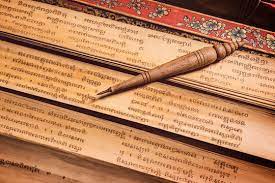The Tripitaka is a compilation of the teachings of Buddha. He taught the masses for 45 years, by orally delivering the sermons by adapting the teaching to suit the group he was addressing. Thus, there is duplication in the texts.
The Sangha memorized the teachings, and there were group recitations at festivals and special occasions. Later, the teachings were rehearsed and authenticated at the First Council and were handed down from generation to generation accurately by means of these group recitations.
The teachings were compiled first at the Fourth Council in Sri Lanka about 25 B.C.E. in Pali. The writing had three sections, Vinaya Pitaka, Sutta Pitaka and Abhidhamma Pitaka, following the division at the Councils, and is called the Tipitaka (three baskets).
The Vinaya Pitaka consists of the 227 rules laying down the conduct and discipline for the monastic life of the monks and nuns. It is divided into three parts and, in addition to the rules, give accounts of the circumstances under which a rule was promulgated and exceptions of the rule.
The Sutta Pitaka is a compilation of the main teaching or Dhamma. It is divided into five Nikayas or collections. These are the long teachings (Digha Nikaya), medium-length teachings (Majjhima Nikaya), groups of shorter teachings according to common topics (Samyutta Nikaya), a collection arranged to subjects discussed (Angutta Nikaya) and a collection of a variety of shorter texts in verse and prose.
The Abhidhamma Pitaka consists of seven books called the higher or further teaching. The writing was on strips of dried palm leaves cut into rectangles and etched with a metal stylus and rubbed over with carbon ink. A thread was passed through the pages to keep them in order and elaborately painted wooden covers fixed at the ends.
